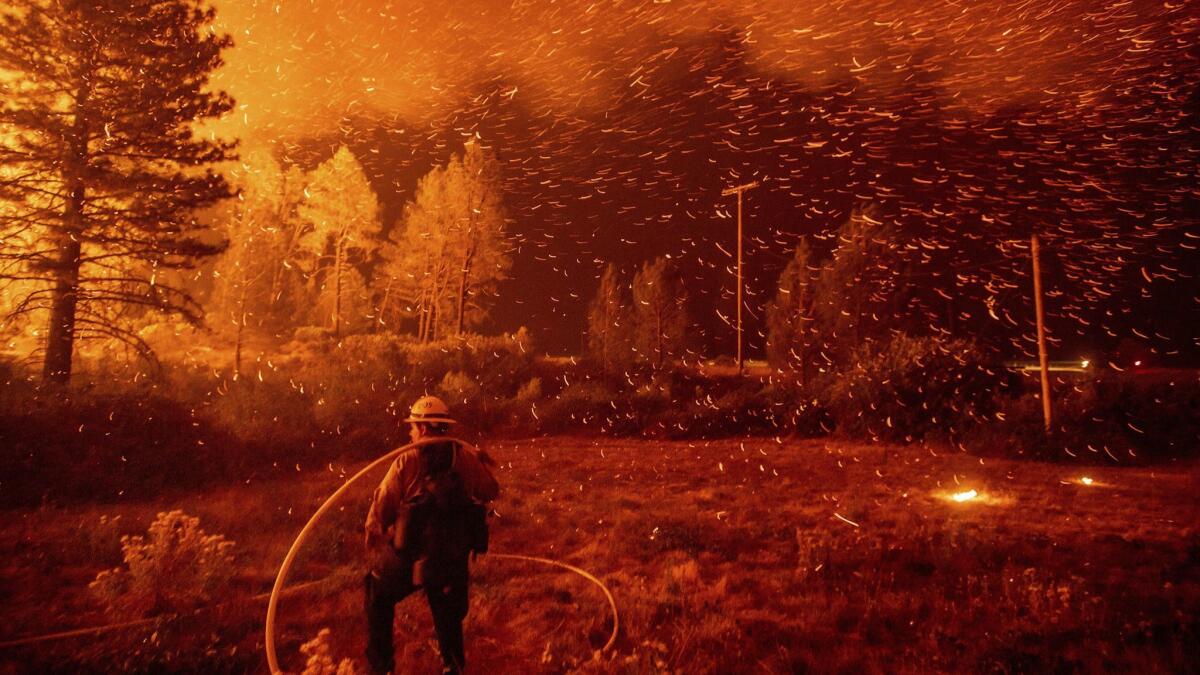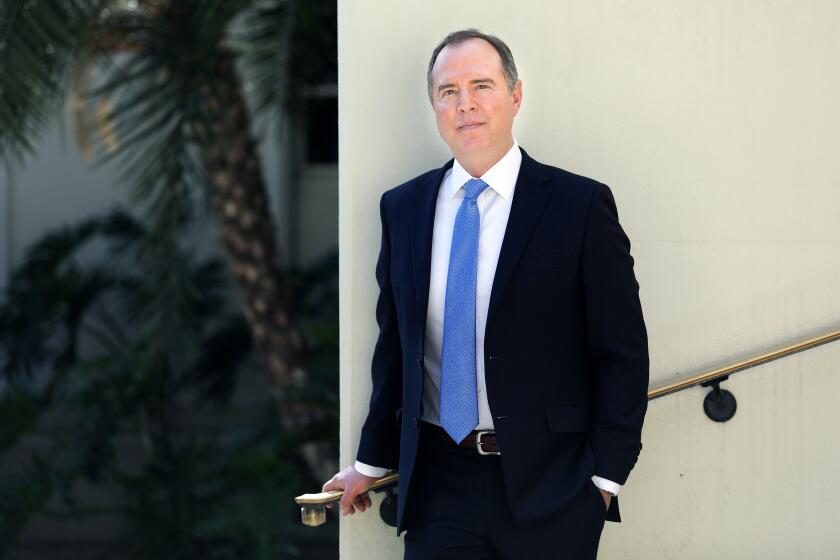As climate change worsens wildfires, California will spend $1 billion and give utilities new ways to shrink their fire expenses

- Share via
Reporting from Sacramento — With an eye toward destructive wildfire as California’s most immediate climate emergency, Gov. Jerry Brown took action on Friday to broadly expand state prevention efforts while allowing utility companies to shift some fire-related costs to their customers.
The far-reaching proposal signed by Brown boosts government fire-protection efforts by $1 billion over the next five years, providing funds that could help clear thousands of acres of dense, dry forests and brittle coastal brush. The bill’s combination of cash and regulatory relief mark a major escalation in addressing what has been called the “new normal” of fire danger for the state, far beyond what has been spent on immediate emergency responses.
“Wildfires in California aren’t going away, and we have to do everything possible to prevent them,” the governor said in a written statement. “This bill is complex and requires investment — but it’s absolutely necessary.”
Negotiations over the details of the 112-page law dominated the state Capitol during the final weeks of the legislative session. The proposal’s fine points emerged just hours before the final vote on Aug. 31. While many lawmakers found parts of the proposal unpalatable, few were willing to be seen as not having done everything they could to protect the lives and property of their constituents.
“This new law is the most comprehensive wildfire-prevention and safety package the state has passed in decades,” said state Sen. Bill Dodd (D-Napa), the bill’s co-author.
The common thread in California’s wildfires: heat like the state has never seen »
The new law links together two distinct challenges for changing the trajectory of California’s fire future: controlled growth of fire-prone vegetation and reduced financial exposure for utility companies. In a less combustible year, opposition to either could have doomed the effort. But the topic was hard to ignore during a summer marked by a number of deadly blazes and weeks of wildfire smoke choking the skies above Sacramento.
Lawmakers from the state’s most threatened regions — rural foothills with forests overgrown from decades of fire suppression, and coastal communities with kindling-like chaparral — were adamant about expanding efforts to remove fire fuels. They pushed for $1 billion in funding, paid over five years from proceeds of California’s cap-and-trade climate program, so that government and landowners alike had the money needed to carry out the work.
California Department of Forestry and Fire Protection officials will oversee those dollars, generally divvied into two categories: $165 million a year for fire-prevention grants to landowners and for community prevention efforts, and another $35 million to continue Cal Fire’s year-round prescribed burns, research and monitoring.
Under the law signed by Brown, landowners will have new permission and help to reduce overgrowth by cutting down more small and mid-sized trees — a historic change, given that California’s logging limits on privately owned lands date back to 1973.
Timber harvesting permits for small landowners will be made cheaper and some property owners will be allowed to build temporary roads to reach otherwise inaccessible overgrown areas. In some instances, both small and large landowners will have new permission to sell that timber to help offset the costs of the fire-prevention activity.
Property owners who apply for new conservation easements — to preserve natural landscapes in exchange for tax incentives — will have to ensure the density and health of their trees don’t exacerbate fire danger. The new law also allows a streamlined state review for tree-removal efforts on federal lands.
California’s Board of Forestry and Fire Protection will have an expanded role in setting regulations to lower fire risk while hiring more technical experts to ensure the rules actually work. Many of the new law’s provisions will expire in five years unless the Legislature decides to continue or expand the programs.
The tree- and brush-removal provisions of Senate Bill 901 were subject to intense lobbying by environmental groups. But those disagreements paled in comparison to the bitter brawl over its concessions to municipal- and investor-owned utilities.
Downed power lines have sparked devastating fires across the state in previous years. Two of the state’s largest electricity providers — Pacific Gas & Electric and San Diego Gas & Electric — both face steep costs related to past wildfires. PG&E has yet to finish tallying the damages it must pay from fires in Napa and Sonoma counties last fall.
SB 901 makes two significant changes to determining how much utilities must pay. First, it enhances the wildfire-mitigation plans that companies must file with the California Public Utilities Commission. Utilities will have to provide new details on vegetation removal and electricity shutoff plans. Regulators will have to formally sign off on the wildfire-mitigation plans, ensuring more accountability in the aftermath of a devastating blaze.
“The bill requires independent evaluation of utility compliance with mitigation plans, and doubles the amount of fines that can be levied upon a utility for failure to comply,” Dodd said during legislative debate last month.
Second, utility regulators will be given new guidelines to help determine a company’s liability. For fires that begin in 2019 and beyond, utility companies will be able to shift some fire-related costs to consumers — but only to the extent that regulators determine the company wasn’t negligent.
For fires that burned in 2017 — a year in which state investigators have linked PG&E equipment to at least a dozen Northern California fires — the utility will be allowed to borrow billions of dollars using ratepayer fees to pay it back, even if it was found to have acted improperly. The amount charged to customers would be determined after an independent analysis of the company’s finances.
Utility officials have given a general rule of thumb: $1 billion in borrowing would result in a $5 annual surcharge for most customers, assessed every year until the loan is paid off. Some lawmakers insisted it will amount to an unfair “bailout” of companies such as PG&E.
“Shouldn’t we focus on requiring PG&E to improve the safety of their electric system that they’ve been neglecting all these years?” state Sen. Jerry Hill (D-San Mateo) said during last month’s floor debate in opposing SB 901. “Instead, this bill rewards their bad behavior.”
Brown, who originally pushed for a more generous plan to lessen the industry’s fire liabilities, insisted the state’s energy needs would be threatened by the specter of utility bankruptcy without some kind of concessions.
“The utilities have to stay in business,” Brown said in an interview with the Los Angeles Times last week. “They have to make enough return to be a viable corporation.”
Even so, the new law will not insulate PG&E from additional financial stress. Last week, Moody’s Investor Service downgraded the company’s credit rating, specifically citing the Legislature’s refusal to go along with Brown’s proposal to revise the liability standard known as “inverse condemnation.”
“Even if a utility prudently managed its infrastructure at the time of a fire, the utility could be held accountable for damages if its infrastructure was substantially involved in causing the fire, potentially exposing the state’s utilities to significant liabilities,” Moody’s analysts wrote.
While SB 901 was the centerpiece of the effort by lawmakers this year in responding to fire danger, Brown also signed several other bills on Friday designed to boost California’s fire preparedness.
Senate Bill 1260 gives Cal Fire a larger role in identifying risks as local communities turn undeveloped land into new housing. Assembly Bill 2911 expands a utility’s right to cross private land to reduce fire threats around power lines, and it sets in motion statewide efforts for new fire-resistant building standards.
Brown and lawmakers from both major political parties insisted the package of new laws are important, but only a first step toward preparing Californians for longer dangerous fire seasons in the years to come.
“This year alone, 1.3 million acres of California have burned,” said Assembly Republican Leader Brian Dahle of Bieber. “The loss of life and property has been staggering. We are taking steps to ensure that this doesn’t happen again.”
Follow @johnmyers on Twitter, sign up for our daily Essential Politics newsletter and listen to the weekly California Politics Podcast.
More to Read
Get the L.A. Times Politics newsletter
Deeply reported insights into legislation, politics and policy from Sacramento, Washington and beyond. In your inbox three times per week.
You may occasionally receive promotional content from the Los Angeles Times.










